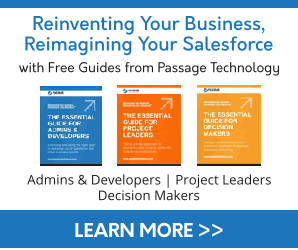How to Set Up Salesforce Development Projects for Success
2025/03/17

The double-edged sword of Salesforce is that you have the capability to customize it, but it can be difficult to achieve the vision you want depending on the experience of your current development team, or the technical debt residing in your org(s). Custom development projects are vital for enhancing efficiency and productivity within your organization. Don't overlook the significance of these projects, as they require a substantial investment of both time and money to do things the right way. Like most things in life, the best way to ensure success is to have the right foundations. Before hitting "start" on your next project, make sure you have all of these items in place.
Define Clear Goals and Objectives
Similar to any project, clearly define the desired goals and outcomes of the project in a project charter or similar document. It may be useful to create a V2MOM document specific to the project. V2MOM stands for Vision, Values, Methods, Obstacles, and Measures. This alignment process was made popular by Salesforce themselves. It covers the goals (vision, values, and methods), while outlining success (measures), and preparing for any unwanted situations or risks that may arise (obstacles).
By outlining these key deliverables, you provide a roadmap for success and ensure that all stakeholders are aligned on the project's direction, no matter who is doing the work. While the project scope may evolve over time, having a clear set of goals will serve as your north star throughout the development process. Depending on the complexity of your project, it is useful to consider project failures or risks that may occur. Thinking of the possibility of what may cause the project to fail or high exposure risks before they materialize is a project management best practice.
Pick the Right Partner for You
The "right" partner will not be the same for every company. Find one that works well for your company size, industry, Salesforce cloud, etc. A more detailed breakdown of how to find the right partner is here.
This step may be optional, depending on how large your internal development team is and how busy or experienced they are.
You'll depend a lot on your development partner to make the project the best it can be. The developer will handle various aspects for you, including architecture, high-quality code, conducting thorough testing, adhering to best practices, and optimizing performance, among others. Therefore, you don't want to skimp out on this step as you want to trust your partner to be in charge of the things you aren't.
Get All Stakeholders on the Same Page
By now, internal and external stakeholders should already be aligned about the goals and objectives outlined earlier. This step is a more detailed breakdown on individual responsibilities and time frames. Be clear about the time commitment you expect from each individual involved in the project, ensuring that they have sufficient dedicated time to focus on the project outside their other responsibilities. For example, "You will give final say on UI elements. It should take you no longer than three business days to respond after the consultant has sent you a draft to review."
It's easier if you can assign tasks in project management software. At Passage Technology, we use Milestones PM+ for our development services projects. Our consultants share their project plan with clients, and we take charge of managing the plan from our end.
User Testing and Feedback
Lastly, don't underestimate the importance of user testing and feedback in the development process. Engage real users (not just management in charge of the project) early on to gather valuable insights that can help shape the final product as they will be the ones actually using it. Remember, processes that don't get user adoption are exactly what we're trying to avoid!
Designate who will be in charge of consolidating and finalizing feedback. This will ensure feedback can stay precise and succinct (especially if different people have conflicting opinions), as well as be a go-to contact for your partner to reach out to instead of multiple individuals.
Testing is more difficult than it looks — which is why there are full-time QA tester positions. To make it easier for your users, have them write up as many use case scenarios beforehand to run through to check for specific bugs and carry out user acceptance testing. Overall, it's much better to catch problems or make changes during development than when it's live.
By clearly defining goals, choosing the right development partner, getting all stakeholders on the same page, and prioritizing user testing and feedback, you are setting yourself up for a smoother and more effective project implementation before the first line of code is ever written. Stay proactive, communicate effectively, and keep the end goal in mind to ensure a successful Salesforce customization project. Have a project you want to talk about? We've been Salesforce partners for over 15 years. Sign up for a free consultation to discuss your project. Some of our client examples include cloud implementations, integrations to other software, and custom processes.
| Solutions That Help Salesforce Business Analysts Succeed | Passage Technology Blog | Salesforce Admin Career Growth Requires a Commitment to Elevating Data Quality |
